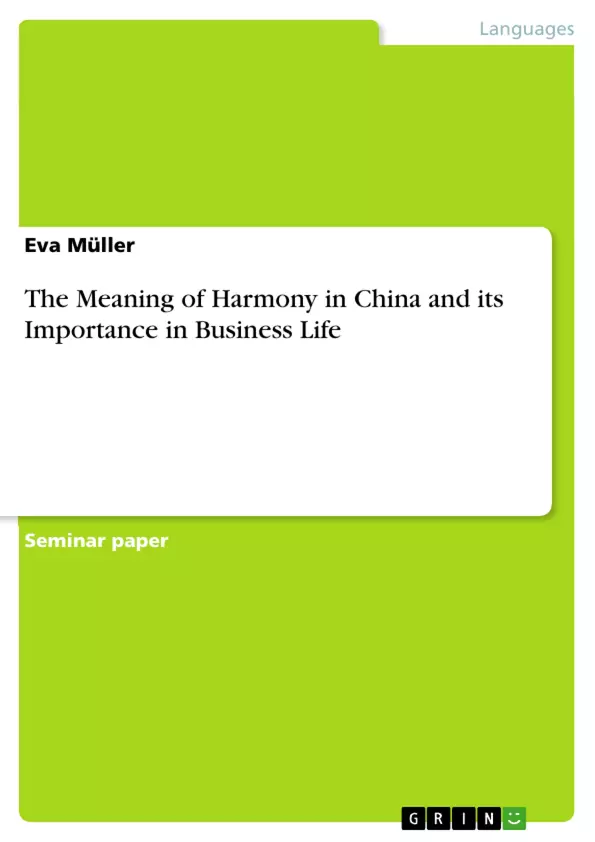The author of this paper is going to introduce the Chinese meaning of harmony by looking at the historical core principles of harmony in China. Then the knowledge is applied to business life and a conclusion will be made.
Table of Contents
- Introduction
- The Meaning and Core Principles of Harmony
- Historical Symbols of Harmony
- Confucianism
- Taoism
- Wuxing
- Yin and Yang
- Harmony in Business
- Guanxi
- Lose Face
- Further Suggestions
Objectives and Key Themes
This paper aims to explore the concept of harmony within Chinese culture and its significance in business life. It examines the historical roots of harmony in Confucianism and Taoism, analyzing core principles and symbols. The paper then applies this understanding to the context of Chinese business practices.
- The meaning and core principles of harmony in Chinese culture.
- Historical interpretations of harmony through Confucianism and Taoism.
- The role of harmony in interpersonal relationships and business interactions.
- The concept of "mianzi" (face) and its impact on maintaining harmony.
- Practical applications of harmony in various aspects of Chinese life.
Chapter Summaries
1. Introduction: This introductory chapter establishes the central theme of harmony within Chinese culture, citing a quote from Xun Zi to highlight its enduring importance. It explains how harmony, defined as "a situation of peace, happiness, and agreement," was crucial for peaceful co-existence in ancient China and remains a highly valued principle in modern Chinese society, impacting various aspects of life, including business interactions. The chapter outlines the paper's objective to examine the Chinese meaning of harmony, its historical core principles, and its application in business life.
2. The Meaning and Core Principles of Harmony: This chapter delves into the multifaceted meaning of harmony in Chinese culture, exploring its applications in music, cuisine, and social interactions. It emphasizes the importance of balance in achieving harmony, particularly in navigating the challenges of a rapidly changing society. The chapter highlights the significance of harmony in interpersonal relationships, especially within the family, emphasizing respect for elders and the principle of reciprocity. It also addresses the importance of harmony in relation to nature, politics, economics, and diplomacy. A key concept introduced is "mianzi" (face), the importance of maintaining and saving face in interactions, and how its loss can disrupt harmonious relationships.
3. Historical Symbols of Harmony: This chapter explores the historical context of harmony by examining the philosophical perspectives of Confucianism and Taoism. It details Confucianism's emphasis on harmony through music, rituals, and the "doctrine of the mean," which promotes balance and equilibrium. The chapter also discusses the Confucian principles of "Li" (etiquette), "Ren" (benevolence), and "Yi" (righteousness) as essential elements in building harmonious relationships. It establishes how these philosophical foundations significantly influenced the development and importance of harmony in Chinese culture.
Keywords
Harmony, Chinese culture, Confucianism, Taoism, business, Guanxi, Mianzi, interpersonal relationships, balance, social harmony, respect, benevolence, righteousness.
Frequently Asked Questions: A Comprehensive Language Preview
What is the overall topic of this academic preview?
This preview summarizes a paper exploring the concept of harmony within Chinese culture and its significance in business life. It examines the historical roots of harmony in Confucianism and Taoism, analyzing core principles and symbols, and applying this understanding to Chinese business practices.
What key themes are discussed in this paper?
Key themes include the meaning and core principles of harmony in Chinese culture; historical interpretations of harmony through Confucianism and Taoism; the role of harmony in interpersonal relationships and business interactions; the concept of "mianzi" (face) and its impact on maintaining harmony; and practical applications of harmony in various aspects of Chinese life.
What are the main sections covered in the preview?
The preview provides a table of contents, objectives and key themes, chapter summaries, and keywords. The chapter summaries cover an introduction to the concept of harmony, a deeper dive into its core principles, an exploration of its historical roots in Confucianism and Taoism, and its application in the context of business.
What is the significance of Confucianism and Taoism in understanding the concept of harmony?
The paper examines Confucianism's emphasis on harmony through music, rituals, and the "doctrine of the mean," highlighting principles like "Li" (etiquette), "Ren" (benevolence), and "Yi" (righteousness). Taoism's contribution is also explored, likely including concepts like Yin and Yang and Wuxing.
How does the concept of "mianzi" (face) relate to harmony?
The concept of "mianzi" (face) is crucial to maintaining harmony. Saving and maintaining face in interactions is emphasized, and the disruption caused by losing face is discussed.
What is the role of harmony in Chinese business practices?
The paper specifically applies the understanding of harmony to Chinese business practices, likely exploring concepts such as Guanxi (relationships) and their impact on business interactions.
What are some key terms or keywords associated with this paper?
Key terms include Harmony, Chinese culture, Confucianism, Taoism, business, Guanxi, Mianzi, interpersonal relationships, balance, social harmony, respect, benevolence, and righteousness.
What is the purpose of this language preview?
This preview serves as a comprehensive overview of the paper's content, allowing readers to quickly grasp the main points and assess its relevance to their academic interests.
Where can I find more detailed information?
The full paper would provide more detailed information on each of the themes and concepts introduced in this preview.
- Quote paper
- Eva Müller (Author), 2012, The Meaning of Harmony in China and its Importance in Business Life, Munich, GRIN Verlag, https://www.grin.com/document/296059



